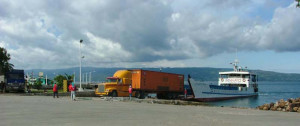 Philippine President Benigno Aquino III has signed an executive order (EO) expanding the country’s Roll-on/Roll-off Terminal System (RRTS) to include chassis Ro-Ro (Cha-Ro), a move seen to cut transportation costs.
Philippine President Benigno Aquino III has signed an executive order (EO) expanding the country’s Roll-on/Roll-off Terminal System (RRTS) to include chassis Ro-Ro (Cha-Ro), a move seen to cut transportation costs.
Aquino on March 29 signed EO No. 204 series of 2016, expanding the coverage of EO 170 (2003) and EO 170-A (2003) to include Cha-Ro in a bid “to further reduce logistics cost and support and promote competitiveness of the export sector.” EO 170 promotes private sector participation and investment in the development and operation of RRTS, while EO 170-A amends the order to expand its coverage.
EO 204 defines Ro-Ro operations as referring to the method of loading and discharging of vehicles between vessel and shore via a ramp, whether self-powered (such as cars, trucks, containers on chassis attached to a prime mover, buses, motorcycles) or containers on chassis loaded onto the Ro-Ro ship by prime mover (or tractor head) at the port of origin and unloaded from the Ro-Ro by a different prime mover (tractor head) at the port of destination.
Cha-Ro is a form of Ro-Ro system in which a container mounted on a chassis is loaded on and off the cargo belly of Ro-Ro ships by a prime mover or a tractor. Unlike the pure Ro-Ro mode, the container-mounted chassis is disengaged from the prime mover, leaving behind the prime mover at the port of origin. The cargo is later picked up by another prime mover at the port of discharge.
Under EO 204, Aquino said “there is a need to expand Ro-Ro definition to include Cha-Ro as part of the Ro-Ro service in order to support and complement the establishment of the Association of Southern Asian Nations (ASEAN) Ro-Ro Project Network and address issues related to the movement of natural persons, Customs, Immigration, Quarantine and Security (CIQS), and technical operations.”
He added that including Cha-Ro in the RRTS concept “will lift the restriction of the Ro-Ro definition to ‘self-driven’ rolling cargoes and, in so doing, reduce the cost of domestic logistics and trans-shipment of export-import cargoes.”
The new order also amends Section 3 of EO 170-A, which now states that the RRTS toll shall be applicable to all self-powered vehicles such as cars, trucks, containers on chassis attached prime mover, buses, motorcycles; containers loaded unto the Ro-Ro ship by prime mover (or tractor head) at the point of origin and unloaded from the Ro-Ro by a different prime mover (or tractor head) at the point of destination; and all vessels to the extent that they are actually engaged in Ro-Ro.
EO 204 applies to domestic as well as international Ro-Ro operations and services.
The Department of Trade and industry, through the Export Development Council (EDC), has been pushing to include Cha-Ro in the RRTS, saying this will promote investment in and development of the RRTS.
In an earlier paper, EDC said including Cha-Ro in the RRTS will cut transport costs by “15-20% mainly because the prime mover, an expensive equipment, is not required to travel with the chassis mounted container onto/from the Ro-Ro ships.”
The use of Cha-Ro, according to EDC, also facilitates faster transit times from warehouse to final destination; addresses the left-hand, right-hand drive issue; eliminates the need for vehicle/driver registration and accreditation; and avoids labor displacement/issue on the movement of natural persons from country to country.– Roumina Pablo





